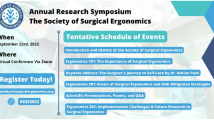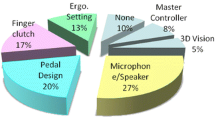Abstract
Background
This study aimed to obtain an answer for the question: Are ergonomic guidelines applied in the operating room and what are the consequences?
Methods
A total of 1,292 questionnaires were sent by email or handed out to surgeons and residents. The subjects worked mainly in Europe, performing laparoscopic and/or thoracoscopic procedures within the digestive, thoracic, urologic, gynecologic, and pediatric disciplines.
Results
In response, 22% of the questionnaires were returned. Overall, the respondents reported discomfort in the neck, shoulders, and back (almost 80%). There was not one specific cause for the physical discomfort. In addition, 89% of the 284 respondents were unaware of ergonomic guidelines, although 100% stated that they find ergonomics important.
Conclusions
The lack of ergonomic guidelines awareness is a major problem that poses a tough position for ergonomics in the operating room.














Similar content being viewed by others
References
Berguer R (1998) Surgical technology and the ergonomics of laparoscopic instruments. Surg Endosc 12: 458–462
Berguer R, Forkey DL, Smith WD (1999) Ergonomic problems associated with laparoscopic surgery. Surg Endosc 13: 466–468
Berguer R, Gerber S, Kilpatrick G, Beckley D (1998) An ergonomic comparison of in-line vs pistol-grip handle configuration in a laparoscopic grasper. Surg Endosc 12: 805–808
Berguer R, Smith WD, Davis S (2002) An ergonomic study of the optimum operating table height for laparoscopic surgery. Surg Endosc 16: 416–421
Emam TA, Frank TG, Hanna GB, Cuschieri A (2001) Influence of handle design on the surgeon’s limb movements, muscle recruitment, and fatigue during endoscopic suturing. Surg Endosc 15: 667–672
Goossens RHM, Van Veelen MA (2001) Assessment of ergonomics in laparoscopic surgery. Min Invas Ther Allied Technol 10: 175–179
Hanna GB, Shimi SM, Cuschieri A (1998) Task performance in endoscopic surgery is influenced by location of the image display. Ann Surg 227: 481–484
Matern U, Faist M, Giebmeyer C, Buess G (2005) Monitor position in laparoscopic surgery. Surg Endosc 19: 436–440
Matern U, Rückauer KD, Farthmann EH (2000) Die Arbeitshaltung des laparoskopisch tätigen Chirurgen: Ideal und Wirklichkeit. Zentralbl Chir 125: 698–701
Matern U, Waller P (1999) Instruments for minimally invasive surgery: principles of ergonomic handles. Surg Endosc 13: 174–182
Matern U, Waller P, Giebmeyer C, Rückauer KD, Farthmann EH (2001) Ergonomics: requirements for adjusting the height of laparoscopic operating tables. JSLS 5: 7–12
Nguyen NT, Ho HS, Smith WD, Philipps C, Lewis C, De Vera RM, Berguer R (2001) An ergonomic evaluation of surgeons’ axial skeletal and upper extremity movements during laparoscopic and open surgery. Am J Surg. 182: 720–724
Omar AM, Wade NJ, Brown SI, Cuschieri A (2004) Assessing the benefits of “gaze-down” display location in complex tasks. Surg Endosc 19: 105–108
Schoofs J, Gossot D (2004) A neglected but frustrating ergonomic issue: the thoracoscopic trocar. Min Invas Ther Allied Technol 13: 133–137
Uhrich ML, Underwood RA, Standeven JW, Soper NJ, Engsberg JR (2002) Assessment of fatigue, monitor placement, and surgical experience during simulated laparoscopic surgery. Surg Endosc 16: 635–639
Van Veelen MA (2003) Human–product interaction in minimally invasive surgery: a design vision for innovative products, TU Delft, Delft, The Netherlands
Van Veelen MA, Jakimowicz JJ, Goossens RHM, Meijer DM, Bussman JBJ (2002) Evaluation of the usability of two types of image display systems during laparoscopy. Surg Endosc 16: 674–678
Van Veelen MA, Kazemier G, Koopman J, Goossens RHM, Meijer DW (2002) Assessment of the ergonomically optimal surface height for laparoscopic surgery. J Laparoendosc Adv Surg Tech A 12: 47–52
Van Veelen MA, Nederlof EAL, Goossens RHM, Schot CJ, Jakimowicz JJ (2003) Ergonomic problems encountered by the medical team related to products used for minimally invasive surgery. Surg Endosc 17: 1077–1081
Van Veelen MA, Snijders CJ, Van Leeuwen E, Goossens RHM, Kazemier G (2003) Improvement of foot pedals used during surgery based on new ergonomic guidelines. Surg Endosc 17: 1086–1091
Author information
Authors and Affiliations
Corresponding author
Rights and permissions
About this article
Cite this article
Wauben, L.S.G.L., van Veelen, M.A., Gossot, D. et al. Application of ergonomic guidelines during minimally invasive surgery: a questionnaire survey of 284 surgeons. Surg Endosc 20, 1268–1274 (2006). https://doi.org/10.1007/s00464-005-0647-y
Received:
Accepted:
Published:
Issue Date:
DOI: https://doi.org/10.1007/s00464-005-0647-y




